
The German People's Party was a conservative-liberal political party during the Weimar Republic that was the successor to the National Liberal Party of the German Empire. Along with the left-liberal German Democratic Party (DDP), it represented political liberalism in Germany between 1918 and 1933.

Otto Braun was a politician of the Social Democratic Party of Germany (SPD) during the Weimar Republic. From 1920 to 1932, with only two brief interruptions, Braun was Minister President of the Free State of Prussia. The continuity of personnel in high office resulted in a largely stable government in Prussia, in contrast to the sometimes turbulent politics of the Reich. During his term of office, Prussia's public administration was reorganized along democratic lines. He replaced many monarchist officials with supporters of the Weimar Republic, strengthened and democratized the Prussian police, and made attempts to fight the rise of the Nazi Party.

The Weimar Coalition is the name given to the centre-leftist coalition of the Social Democratic Party of Germany (SPD), the social liberal German Democratic Party (DDP) and the Christian democratic Centre Party, who together had a large majority of the delegates to the Constituent Assembly that met at Weimar in 1919, and were the principal groups that designed the constitution of Germany's Weimar Republic. These three parties were seen as the most committed to Germany's new democratic system, and together governed Germany until the elections of 1920, when the first elections under the new constitution were held, and both the SPD and especially the DDP lost a considerable share of their votes. Although the Coalition was revived in the ministry of Joseph Wirth from 1921 to 1922, the pro-democratic elements never truly had a majority in the Reichstag from this point on, and the situation gradually grew worse for them with the continued weakening of the DDP. This meant that any pro-republican group that hoped to attain a majority would need to form a "Grand Coalition" with the conservative liberal German People's Party (DVP), which only gradually moved from monarchism to republicanism over the course of the Weimar Republic and was virtually wiped out politically after the death of their most prominent figure, Foreign Minister Gustav Stresemann in 1929.
In the fourteen years the Weimar Republic was in existence, some forty parties were represented in the Reichstag. This fragmentation of political power was in part due to the use of a peculiar proportional representation electoral system that encouraged regional or small special interest parties and in part due to the many challenges facing the nascent German democracy in this period.

Presidential elections were held in Germany on 29 March 1925, with a runoff on 26 April. They were the first direct elections to the office of President of the Reich, Germany's head of state during the 1919–33 Weimar Republic. The first President, Friedrich Ebert, who had died on 28 February 1925, had been elected indirectly, by the National Assembly, but the Weimar Constitution required that his successor be elected by the "whole German people". Paul von Hindenburg was elected as the second president of Germany in the second round of voting.
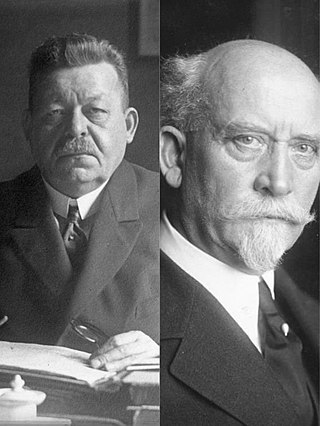
Federal elections were held in Germany on 19 January 1919, although members of the standing army in the east did not vote until 2 February. The elections were the first of the new Weimar Republic, which had been established after World War I and the Revolution of 1918–19, and the first with women's suffrage. The previous constituencies, which heavily overrepresented rural areas, were scrapped, and the elections held using a form of proportional representation. The voting age was also lowered from 25 to 20. Austrian citizens living in Germany were allowed to vote, with German citizens living in Austria being allowed to vote in the February 1919 Constitutional Assembly elections.

The Free State of Prussia was one of the constituent states of Germany from 1918 to 1947. The successor to the Kingdom of Prussia after the defeat of the German Empire in World War I, it continued to be the dominant state in Germany during the Weimar Republic, as it had been during the empire, even though most of Germany's post-war territorial losses in Europe had come from its lands. It was home to the federal capital Berlin and had 62% of Germany's territory and 61% of its population. Prussia changed from the authoritarian state it had been in the past and became a parliamentary democracy under its 1920 constitution. During the Weimar period it was governed almost entirely by pro-democratic parties and proved more politically stable than the Republic itself. With only brief interruptions, the Social Democratic Party (SPD) provided the Minister President. Its Ministers of the Interior, also from the SPD, pushed republican reform of the administration and police, with the result that Prussia was considered a bulwark of democracy within the Weimar Republic.
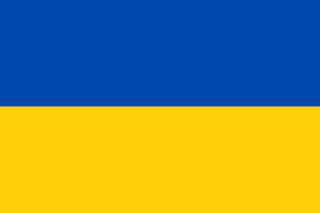
The Free State of Brunswick was a state of the German Reich in the time of the Weimar Republic. It was formed after the abolition of the Duchy of Brunswick in the course of the German Revolution of 1918–19. Its capital was Braunschweig (Brunswick).
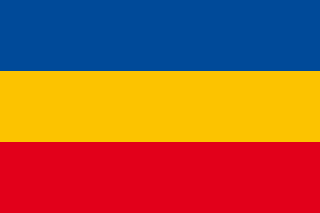
The Free State of Mecklenburg-Schwerin was a state in the Weimar Republic that was established on 14 November 1918 upon the abdication of the Grand Duke of Mecklenburg-Schwerin following the German Revolution. In 1933, after the onset of Nazi rule, it was united with the smaller neighbouring Free State of Mecklenburg-Strelitz to form the new united state of Mecklenburg on 1 January 1934.
A referendum to expropriate the property of the former ruling houses was held in Germany on 20 June 1926. Although a majority of those who voted voted in favour, the voter turnout of 39% was too low for the proposal to pass into law.
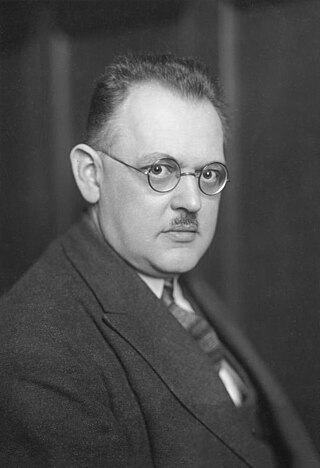
The First Cabinet Müller was the third democratically elected government of Germany and the second in office after the Weimar Constitution came into force in August 1919. It was named after the new Chancellor (Reichskanzler) Hermann Müller of the Social Democratic Party of Germany (SPD). The cabinet was based on the same three centre-left parties as the previous one: the SPD, the German Center Party (Zentrum) and the German Democratic Party (DDP). It was formed in March 1920 after the resignation of the Cabinet Bauer. The Cabinet Müller resigned in reaction to the outcome of the Reichstag elections of 6 June 1920.

The Fehrenbach cabinet was the fourth democratically elected Reichsregierung of the German Reich. It was named after Reichskanzler (chancellor) Constantin Fehrenbach and took office on 25 June 1920 when it replaced the First Müller cabinet.

The First Wirth cabinet was the fifth democratically elected Reichsregierung of the German Reich. It was named after Reichskanzler (chancellor) Joseph Wirth and took office on 10 May 1921 when it replaced the Fehrenbach cabinet.
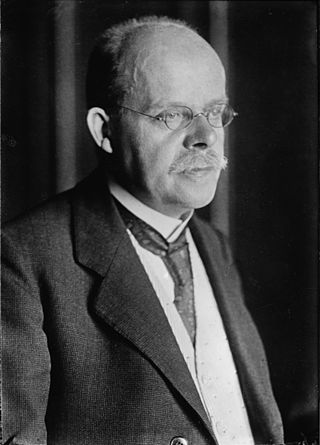
The First Marx cabinet was the tenth democratically elected government during the Weimar Republic. The cabinet was named after Chancellor Wilhelm Marx and took office on 30 November 1923 when it replaced the Second Stresemann cabinet which had resigned on 23 November. Marx' first cabinet resigned on 26 May 1924 and was replaced on 3 June by another cabinet under his chancellorship.

The Second Marx cabinet was the 11th democratically elected government during the Weimar Republic. The cabinet was named after Chancellor Wilhelm Marx and took office on 3 June 1924 when it replaced the First Marx cabinet which had resigned on 26 May. Marx's second cabinet resigned on 15 December 1924 and was replaced on 15 January 1925 by a cabinet led by Hans Luther.

The Second Luther cabinet was the 13th democratically elected Reichsregierung of the German Reich, during the period in which it is now usually referred to as the Weimar Republic. The cabinet was named after Reichskanzler (chancellor) Hans Luther and was in office for not quite four months. On 20 January 1926 it replaced the First Luther cabinet which had resigned on 5 December 1925. Luther resigned as chancellor on 13 May 1926. His cabinet remained in office as a caretaker government until 17 May 1926, but was led by Otto Gessler in its final days. On 17 May, Wilhelm Marx formed a new government, virtually unchanged from the second Luther cabinet except for the departure of Luther.

The Third Marx cabinet was the 14th democratically elected government during the Weimar Republic. The cabinet was named after Chancellor Wilhelm Marx and was in office for only seven months. On 17 May 1926 it replaced the Second Luther cabinet after the resignation of Hans Luther on 13 May 1926. Marx resigned with his cabinet on 17 December 1926 but remained in office as caretaker. He formed another government on 29 January 1927.
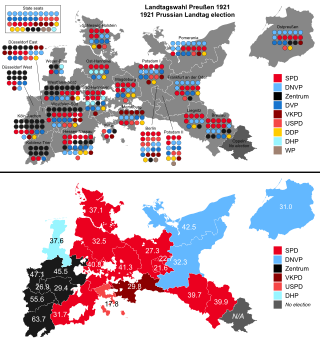
State elections were held in the Free State of Prussia on 20 February 1921 to elect 406 of the 428 members of the Landtag of Prussia. The governing coalition of the Social Democratic Party, Centre Party, and German Democratic Party suffered major losses, losing one-third of its collective voteshare from 1919, but retained a narrow majority. The right-liberal German People's Party (DVP) and reactionary nationalist German National People's Party (DNVP) made the largest gains, with the DNVP becoming the second largest party by voteshare. The Communist Party of Germany contested its first Prussian election, winning 31 seats.
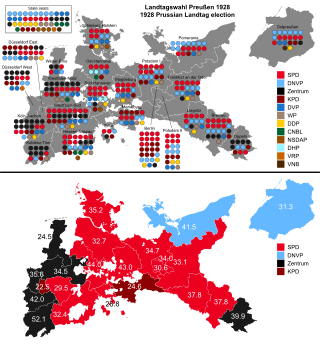
State elections were held in the Free State of Prussia on 20 May 1928 to elect all 450 members of the Landtag of Prussia. The governing coalition of the Social Democratic Party, Centre Party, and German Democratic Party retained its majority. The SPD recorded its best result since 1919 while the opposition German National People's Party suffered significant losses. The Centre Party, German People's Party, and DDP took modest losses; the Communist Party and Wirtschaftspartei made modest gains.

State elections were held in the Free State of Prussia on 24 April 1932 to elect all 423 members of the Landtag of Prussia. They were the last free election in Prussia, as the next election in 1933 took place under the Nazi regime, and Prussia was then abolished after World War II.

















